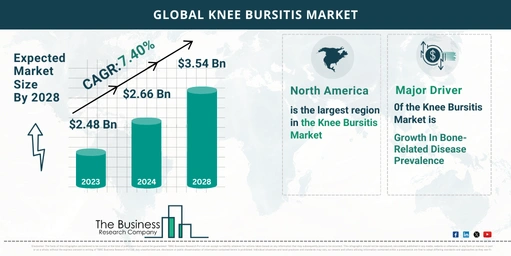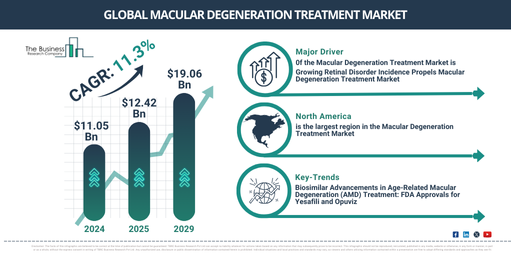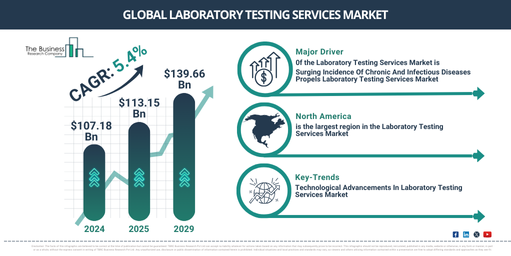Knee Bursitis Market Growth Analysis Till 2033 By The Business Research Company
The Business Research Company’s market reports offer an in-depth analysis on the market’s growth potential, major drivers, key trends and more.
Market Overview
- Current Market Size:
- The knee bursitis market was valued at $2.48 billion in 2023. It is projected to grow to $2.66 billion in 2024, reflecting a compound annual growth rate (CAGR) of 7.3%.
- Future Projections:
- By 2028, the market is expected to reach $3.54 billion, with a CAGR of 7.4%.
Key Drivers of Market Growth
- Aging Population:
- An older demographic is more susceptible to knee bursitis due to age-related wear and tear.
- Increased Physical Activity:
- More people participating in sports and physical activities is leading to higher instances of knee injuries, including bursitis.
- Improved Diagnostics and Healthcare Access:
- Better diagnostic techniques and enhanced access to healthcare services have led to increased detection and treatment of knee bursitis.
- Education Programs:
- Training and education for healthcare professionals and patients have improved understanding and management of knee bursitis.
Read More On The Knee Bursitis Market Report 2024 – https://www.thebusinessresearchcompany.com/report/knee-bursitis-global-market-report
Future Growth Drivers
- Awareness Campaigns:
- Increased public awareness about prevention and management of knee bursitis is expected to boost market growth.
- Rising Disposable Income and Healthcare Expenditure:
- Growing income levels and higher spending on healthcare contribute to increased treatment access and affordability.
- Advancements in Diagnosis and Treatment:
- Continuous improvements in diagnostic techniques and novel therapies are anticipated to drive market expansion.
Impact of Bone-Related Diseases
- Bone-Related Disease Prevalence:
- Conditions like osteoporosis, arthritis, and bone cancer affect the skeletal system, leading to increased incidences of knee bursitis.
- Factors Contributing to Bone-Related Diseases:
- Aging, sedentary lifestyles, poor nutrition, and environmental changes are key factors contributing to these conditions.
- Impact on Knee Bursitis:
- Diseases such as osteoarthritis and rheumatoid arthritis cause inflammation and pressure on the knee bursa, leading to pain and reduced joint function.
- Statistics:
- In September 2022, Healthy Bones Australia reported that 6.2 million individuals aged 50 and above were affected by osteoporosis or osteopenia, highlighting the prevalence of bone-related diseases.
Market Segmentation
- By Diagnosis:
- Imaging Tests
- Other Diagnostic Tests
- By Treatment:
- Medication
- Therapy
- Surgery
- Other Treatments
- By End User:
- Hospitals and Clinics
- Diagnostic Centers
- Research Centers
- Academic Institutes
- Other End Users
Regional Insights
- North America:
- In 2023, North America was the largest market for knee bursitis, driven by advanced healthcare infrastructure and high diagnosis rates.
- Asia-Pacific:
- Expected to be the fastest-growing region, due to increasing healthcare investments and rising awareness about knee bursitis.
Conclusion
- The knee bursitis market is experiencing robust growth, driven by demographic changes, increased physical activity, and advancements in healthcare.
- Rising awareness, improvements in diagnostic and treatment methods, and the growing prevalence of bone-related diseases are key factors contributing to market expansion.
- With North America leading the market and Asia-Pacific emerging as a fast-growing region, the knee bursitis market is poised for continued growth and innovation in the coming years.
Request for A Sample Of The Global Knee Bursitis Market Report:
https://www.thebusinessresearchcompany.com/sample_request?id=16460&type=smp



